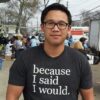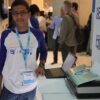Example #4: Common Core Quiz (Kelvin Doe)
Draft————–Draft————Draft
Example #4: Common Core Quiz
Kelvin Doe Makes Radio Station out of Trash
Lexile Measure 990L Mean Sentence Length 17.36 Mean Log Word Frequency 3.76 Word Count 486
Readability average grade level 8.0
Most kids rather carelessly throw lots of stuff in the trash. Fifteen year-old Kelvin Doe of Sierra Leone finds stuff in the trash. From trash, he built a radio station. The station broadcasts news and music and now Kelvin is known as DJ Focus. He has engaged the help of classmates (average age 12) to report the news every day in his community.
In order to give the youth of his village a voice, he thought they needed a radio station. For that, he would need a transmitter. He went to work figuring out how to make one. Kelvin’s amazing ability to make a transmitter out of junk caught the attention of a fellow countryman, David Sengeh. Sengeh is a graduate student at the famous Massachusetts Institute of Technology (MIT). Sengeh was so impressed with Kelvin that he arranged for him to come to MIT for three weeks. Sengeh tapped into the MIT International Developers Initiative, which paid for Kelvin’s airfare to the US. Kelvin, who had never previously been further than ten miles from home, made history by becoming the youngest person ever to come to MIT on that program.
One and half billion people around the globe need electricity. For that reason, a windmill is to be Kelvin’s next project.
Sengeh made a video of Kelvin’s inventions. It also shows him coming to MIT. Several colleges have offered Kelvin a full scholarship to come back to get a full university education.
Quiz
CCSS.ELA-LITERACY.RI.7.3Analyze the interactions between individuals, events, and ideas in a text (e.g., how ideas influence individuals or events, or how individuals influence ideas or events).
Question 1. Explain why Kelvin was invited to MIT, including the people and events that influenced Kelvin.
- David Sengeh invited Kelvin to MIT so that Kelvin could find a way to take the trash he found in his hometown and turn it into a transistor for his radio.
- The MIT International Developers Initiative found out about DJ Focus, who recommended that Kelvin research windpower at MIT with the assistance of David Sengeh. Kelvin then traveled all the way to the United States to be the youngest person to be a part of the program.
- Kelvin constructed a radio from trash in his home in Sierra Leone. David Sengeh, a graduate student at MIT who was impressed with Kelvin’s work, invited Kelvin to study there as part of the MIT International Developers Initiative.
- Listeners to DJ Focus contacted David Sengeh and requested that Kelvin be invited to MIT for the MIT International Developers Initiative.
CCSS.ELA-LITERACY.RI.7.1 Cite several pieces of textual evidence to support analysis of what the text says explicitly as well as inferences drawn from the text.
Kelvin Doe’s radio station was successful and reached a lot of listeners.
Question 2. Choose the best piece of textual evidence to support the above inference.
- Kelvin is known as DJ Focus, and he broadcasts news and music over his radio station with the help of his classmates.
- David Sengeh worked with Kelvin Doe at the Massachusetts Institute of Technology.
- Kelvin built the radio station out of trash he found in his town and became the youngest person to participate in the MIT International Developers Initiative.
- Kelvin caught the attention of David Sengeh by finding a way to develop a transistor so that the youth of Kelvin’s village would have a voice.
CCSS.ELA-LITERACY.RI.7.2 Determine two or more central ideas in a text and analyze their development over the course of the text; provide an objective summary of the text.
Question 3. Which of these details be unnecessary to include in an objective summary of the text?
- Kelvin Doe is from the country of Sierra Leone. Since he did not have access to advanced radio technology, he used pieces of trash to build his own radio station. He broadcasts locally under the pseudonym “DJ Focus.”
- Kelvin is only fifteen years old. David Sengeh was so impressed with Kelvin that he invited him to study at MIT. When he traveled to MIT, Kelvin became the youngest person to be invited there as part of the MIT International Developers Initiative.
- Kelvin now plans to research windpower because one and a half billion people around the world need electricity. He is experienced using non-traditional materials to construct technology, so this next project will continue that work.
- Kelvin’s radio station is so impressive because it is made only from trash. Before discovering Kelvin, David Sengeh did not know that it was possible to construct a radio transistor from garbage. Kelvin is responsible for educating his peers about radio technology.
CCSS.ELA-LITERACY.RI.7.6Determine an author’s point of view or purpose in a text and analyze how the author distinguishes his or her position from that of others.
Question 4. “Most kids rather carelessly throw lots of stuff in the trash. Fifteen-year-old Kelvin Doe of Sierra Leone finds stuff in the trash. From trash, he built a radio station.”
How does the sentence “Most kids rather carelessly throw lots of stuff in the trash” serve the author’s purpose for writing this article?
- It provides an engaging first sentence so that the reader will be entertained by the passage.
- It informs the reader of a fact the reader may not have known before.
- It introduces the content of the article by informing the reader how Kelvin is different from most other kids.
- It explains the process that led to Kelvin’s idea to build a radio station; he realized that reusing the trash would be a way to be ecologically conscious.




